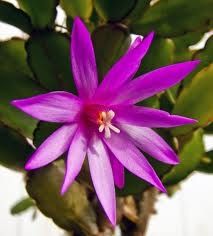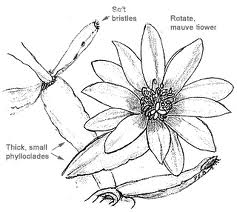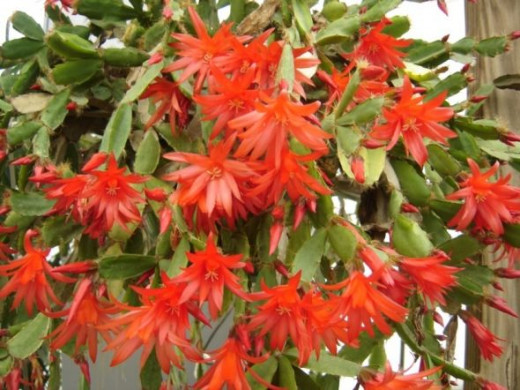Easter Cactus

The Easter Cactus is Often Confused with the Christmas Cactus or Thanksgiving Cactus...
Do you know the difference? I didn't until recently...and actually wasn't aware that there are three types of holiday cactus: Easter Cactus, Thanksgiving Cactus, and Christmas Cactus.
I thought I was most familiar with the latter, but upon further research discovered I didn't know much! First of all, these cacti tend to bloom around their namesake holidays. At a quick glance they look very similar in appearance with their trademark arching, trailing stem segments.
Let's explore their similarities: They all originate in the tropical jungles of Brazil. They share similar care requirements and propagation methods. The various holiday cactus can live a very long time and be low maintenance if their basic needs are met.
As for differences: The Easter cactus and Christmas cactus both have more rounded, or scalloped stem sections. The Thanksgiving cactus stem sections are deeply indented with pointed crab-like "claws" at the ends. The Easter cactus also has yellow bristles instead of spines. The pretty flowers of the spring blooming cacti are more daisy-shaped (or starburst) and bell-like than its counterparts (see the photo at left)
Phew...are you confused? Relax, I'll go into greater detail and illustrate below.

Easter Cactus Traits
Besides the differing bloom times from the Christmas cactus and Thanksgiving cactus, the leaf pads and flowers are different on the Easter Cactus. Easter cacti are characterized by scalloped stem sections with tufts of yellow bristles instead of spines. (see diagram below)
Referred to as 'Rhipsalidopsis gaertneri' or more recently 'Hatiora gaertneri', Easter cacti originate from the tropical forests of southern Brazil. (Christmas and Thanksgiving cactus are members of the 'Schlumbergera' botanical family). These are not the typical desert, dry-loving cacti ... so they like more humid conditions. I've discovered they like to be misted about once a week.
In spring, the segments at the tips of the branches produce flowers. The flowers or blooms are colorful and bell-shaped. To me the flowers are a bit daisy-like (mutiple petals) and distinct from the Christmas or Thanksgiving cacti's more tubular blooms with their prominent stamens.
Holiday cacti are mostly epiphytic, which means they grow on the trunks and branches of trees in their native habitat. They most often root into decaying leaves, and bark of their host trees (rather than rooting into the ground).
Easter Cactus Diagram


Easter Cactus Flowers
Usually between February and March, the prolific Easter Cactus begins to form flower buds. The cheery flowers with layers of petals emerge - commonly in shades of red, coral, pink, and purple (or more rarely in white and yellow). They are best described as bell-shaped and quite daisy-like.
You may notice the flowers opening at dawn and closing when the sun goes down...a cool feature of this holiday cactus. Each flower is typically 2 inches in diameter and lasts for a few weeks or more. The flowering season lasts several weeks into middle spring...and what a delightful show!
After the blooming period, let the cactus rest for a month. During this time water sparingly and do not fertilize. Resume normal watering and fertilizing after 4 - 6 weeks.
The drooping habit of this plant makes it a good selection for hanging baskets as well as containers. When the plant is budding or blooming, refrain from moving the cactus to a new location or even turning it. Any movement can unfortunately result in the blooms dropping.
Easter Cactus Poll - Please take a moment to respond ... thank you!
Have You Ever Heard of Easter Cactus? (Before reading this lens)

Where To Buy Easter Cactus
As well as the other "holiday cacti"
In the spring, you'll likely see a few holiday cactus plants for sale at large merchandise retailers like Home Depot or Target. You may have good luck buying plants there, but that isn't guaranteed.
Most plants have special care needs, and think about it...plants for sale at big retailers most likely are not getting the best care or attention they deserve.
We prefer dealing with a trusted mail order gardening outlet. First of all, they know how to care for plants (and their reputation depends on it). Also, they're experienced in shipping plants so they don't get damaged and they offer a guarantee if anything goes wrong or you're not satisfied.
Buy Holiday Cactus Plants ... Easter, Thanksgiving, and Christmas - Click Here!
Make sure to take a look at the beautiful Holiday Cactus Collections via the link above. It'll get you into the holiday cactus spirit ... no matter what time of year! They make great, long-lasting gifts.
Easter Cactus Tip
Keep the soil lightly moist when the plant is in bloom...but do not overwater. Overwatering is the #1 killer of Easter Cactus! (Yellow stems indicate overwatering)
Easter Cactus Blooms Video - Check Out All The Colors of Easter Cacti Flowers!
7 Tips For a Happy Easter Cactus - Follow these for a healthy indoor plant!
- Place your Easter Cactus in bright, filtered sunlight
- Allow the surface to dry out between waterings
- Mist the foliage occasionally for humidity (or stand the pot on a tray of wet pebbles)
- Fertilize every month (except during the rest period after flowering) with a diluted liquid cactus fertilizer
- Good drainage is essential to a long-lived plant
- Do not move or even turn the cactus when it is forming buds (they are prone to fall off)
- A cool resting period is the key to good flowering ... avoid keeping your Easter cactus in a hot room in the winter
Easter Cactus Tip
Dull, limp, wrinkled segments signal the cactus is short of water.

Easter Cactus Propagation, Repotting & Trimming
Do you want to propagate your Easter cactus? It's quite simple...no green thumb required!
Easter cactus are rooted by breaking off 2 or 3 stem segments on one individual main stem. The bottom stem segment is then placed into potting soil mix a few days after cutting. (Let it dry out for at least 24 hours before placing in the prepared pot)
The segment should be placed 1/2 way into the soil mix and the stem misted only, you do not water the soil mix until roots are present...approx. 2-5 weeks depending on time of the year.
It's best to propagate after the cactus has bloomed for the season - so try in spring or summer. That's a good time to repot the parent plant, if needed. Every two or three years should suffice when you notice the cactus getting rootbound.
An occasional "trim" is good for your plant too. This helps give your cactus a fuller and more even shape and encourages new stem growth. Remember: more stems equals more blooms! Always cut Easter Cactus at a joint...usually no tool is required since they can be snapped off so easily at the joint with just your fingers.
I like to use a potting soil mix formulated specifically for cactus and indoor citrus trees - like the one produced by the Miracle Gro folks. You can use plastic or ceramic pots for your Easter cactus. I always prefer the latter for my houseplants since ceramic tends to breathe better. Of course, more important than the material of the container is the drainage capability. Good drainage is very important! You don't want the roots to rot.
Easter Cactus Tip
If you bring your plant outdoors in the summer - choose a sheltered, shady location.
Gorgeous!








